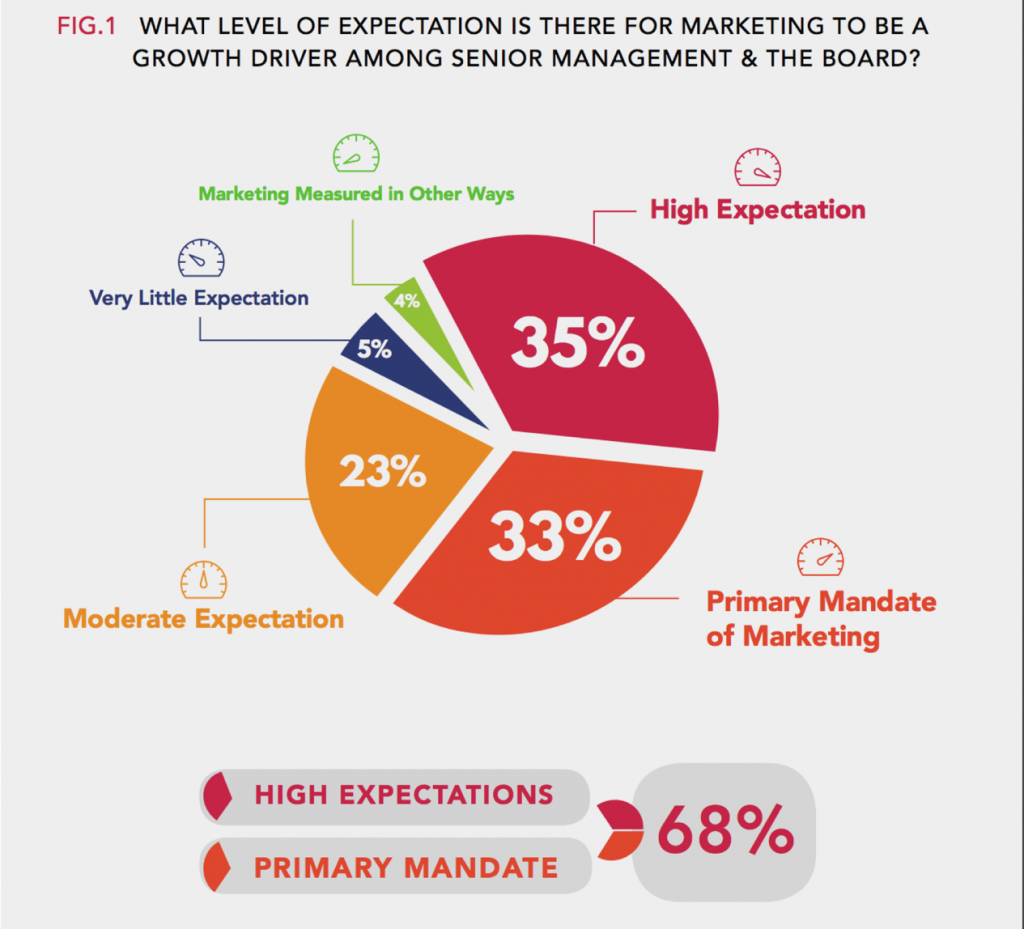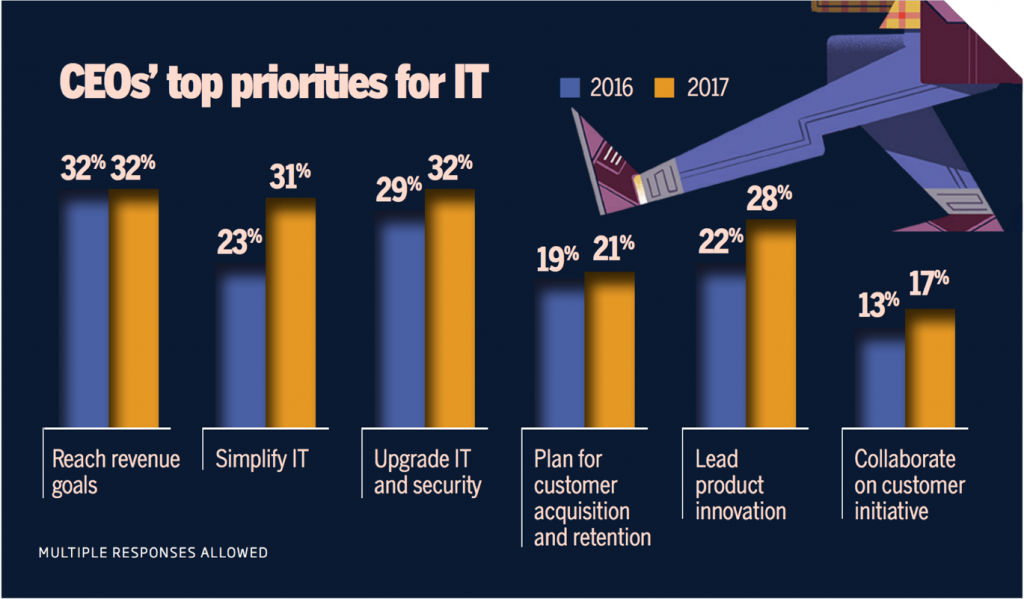Whether you’re a B2C retailer, or a B2B software provider, you’re probably well aware that the future profitability of your company rides on the consumer experiences you provide. But you might not know that there’s one relationship in the C-suite you have to get right before you can deliver on those great consumer experiences — the one between the Chief Marketing Officer (CMO) and Chief Information Officer (CIO).
“The CMO and CIO relationship is becoming one of the most important C-suite collaborations when it comes to delivering the kind of the digital experiences that customers demand,” notes research by Deloitte Digital.
A healthy partnership between these two executive positions is what helps companies like Nike deliver seamless consumer experiences across retail stores, ecommerce, and mobile by tying together technologies like in-store interactive kiosks, mobile apps, GPS technology, and online interactions.
And while it seems obvious that the right technology can also make or break the consumer experience, what’s not so obvious is how the CMO and CIO can best work together to drive business outcomes when these roles have a history of being disconnected.
Read on for five things CMOs can do to help improve their relationship with CIOs, stay competitive on consumer experience, and improve business results.
Why so much tension?
There’s no shortage of stats out there demonstrating the friction between CMOs and CIOs. One hotbed of contention frequently mentioned is the speed at which IT addresses marketing’s requests for technology.
Because the digital landscape changes so quickly, and marketing is under pressure to quickly adapt to consumer needs, CMOs have found it difficult to wait for IT to test and approve their requests. In fact, 43 percent of CMOs say that the technology development process is too slow.
IT, on the other hand, which has historically focused on security and operations, has criticized marketing for wanting things too quickly without taking the time to prioritize or consider risk factors, and even bypassing IT altogether.
And with marketing technology spend on track to exceed overall IT spend this year, if CIOs don’t work closely with CMOs to help guide those tech purchases, this friction is likely to stick around.
This graphic from Gartner gives a glimpse into some of the reasons behind the disconnect between CMO and CIO.
While it’s helpful to understand where we’ve been, the CMO and CIO relationship appears to be on the upswing.
Research shows that 46 percent of CIOs note that the CMO and CIO relationship has become much or somewhat closer compared to a year ago, while 17 percent note that improving the CMO and CIO relationship is a major directive of the CEO. However, the same study showed that 44 percent of CIOs think the relationship has remained the same, so clearly there’s room for improvement.
5 ways CMO and CIO alignment can drive revenue growth
If you feel like you’re not working as effectively as you should with your CIO, here are five things you can do to bring about the outcomes your organization needs to stay competitive:
1. Understand your respective roles
As a CMO you’re aware how the renewed focus on the consumer has shifted your role from one largely centered on branding and creative to a role focused on advancing growth strategies and driving ROI.
According to a CMO Council study, 68 percent of CMOs and senior marketing leaders state that there is either a high expectation for CMOs to drive growth, or that growth is their primary mandate.
As organizations strive to become more analytics-driven, CMOs specifically need to find ways to generate actionable insights from audience data to increase that revenue stream, and keep an eye on innovation to drive better consumer experiences.
Similarly, the CIO’s role is changing from one that has historically been viewed as inward-facing with an eye on increasing productivity and reducing costs, to a role that facilitates innovation and provides business value.
According to CIO.com’s 2017 State of the CIO, CEOs note that their top priorities for IT are to reach revenue goals, and upgrade IT and security.
For CIOs, these shifting priorities mean placing more emphasis on consumer-focused initiatives, including building the infrastructure needed to fuel revenue growth associated with audience data.
In the CIO.com study, David Walsh, vice president of technology for men’s apparel company Haggar Clothing, describes how their company is struggling to generate value from their data to improve the consumer experience.
“We’re collecting a wealth of data, and we’re not getting all of the value out of it that we can,” he stated in the study. “Data is coming to us faster and faster, and the window we have to respond is getting smaller and smaller. We need to understand what’s going on across all of our customers — that’s the chore.”
With a better understanding of the changing roles in marketing and technology, expectations, and challenges, you can then begin to define shared interests and goals to help you strengthen the relationship.
2. Identify shared interests — and shared metrics
Although it’s easy to point out the disconnect between the CMO and CIO roles, finding common ground is a good way to move your relationship in a positive direction.
“The conversation about CIOs and CMOs as partners is focused primarily on why these two executives can’t get along,” noted Jennifer Beck, former VP and research fellow for Gartner. “But if you fundamentally believe IT and marketing need to work effectively together in more creative and collaborative ways, then continuing to harp on their differences just isn’t helpful.”
In her article, she notes that — not surprisingly — two topics common to both roles include the fact that they “love” technology, and that they rely on making sound decisions about technology in order to drive value for business.
However, as buyers now have the power to make more informed purchasing decisions and tune out any brand messaging that’s not relevant to them, the most important shared interest in business today is really the consumer experience.
In order to keep CIOs and CMOs accountable for their roles in impacting the consumer experience, it’s important to define shared goals, as well as metrics around key performance indicators (KPIs) like revenue generation, usage, and customer retention. Shared measures and KPIs should tie back to overall organizational goals, and focus on areas that both teams can accelerate by partnering more closely.
3. Define how you’ll work together
Laying ground rules around how each role and team is expected to interact with each other in the decision-making process can help prevent major issues down the road.
This is where an effective decision governance framework can be invaluable. This framework should clearly state how the CMO, CIO, and perhaps other C-suite executives and their teams should work to support each other. Your decision governance framework should cover when decisions are needed, what should be decided, and who should make those decisions.
These parameters are critical, as companies still struggle to define questions around who should lead their digital transformation efforts, and who owns audience and consumer data.
For example, when it comes to buyer data, CIOs should be responsible for managing the flow of data within the organization, while giving CMOs and other stakeholders access to front-end systems so they have the tools they need to make better decisions to improve the buyer experience.
4. Commit to communication and cross functionality
Keep the relationship with the CIO healthy by developing a deep understanding of how the technology function operates, and encouraging the CIO to do the same with the marketing team.
Start by increasing communication between teams, both at work and socially. Gather your teams in formal meetings on a regular basis to make sure your goals are aligned, and host quarterly social gatherings so both teams can interact and build up the trust necessary to keep their relationships strong and productive.
In addition to frequent communication, working cross functionally can help bridge the gap between the two functions.
Computer Sciences Corporation (CSC) is a good example of how a positive relationship between marketing and technology can work through cross functional efforts. The company’s marketing team is divided into three areas – infrastructure, content marketing and demand generation — all of which use different programs and platforms in the marketing technology stack.
By having a better handle on technology, CSC’s marketing team has been able to more closely work with IT as a guide in recommending and vetting new technologies, while keeping marketing moving at the speed they require.
5. Form a partnership
Akamai, a content delivery network provider, is another example of how the CMO and CIO can become work partners. As the company was getting started with its digital transformation several years ago, they had just brought on a new CIO. Working as a strategic team, the CMO and CIO mapped out their digital transformation strategy, developed cross-functional governance practices, and co-sponsored key initiatives.
As a result, Akamai launched a new website with a new CMS, implemented a new marketing automation system, overhauled their lead processes and completed a Salesforce automation integration in one calendar year, with no downtime.
“Overnight, we went from our old system to our new system and it all worked fantastically,” noted Brad Rinklin, Akamai’s former CMO. “We couldn’t have done that as a marketing team alone or just asking for some IT help. We had to do this as a partnership.”
Proving the ROI of social media and content marketing is difficult — but not impossible. We created The Marketer’s Field Guide to Social and Content Marketing Attribution to show you how to prove your impact. Get your free copy now!



